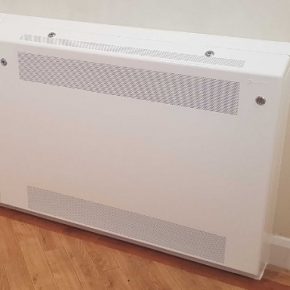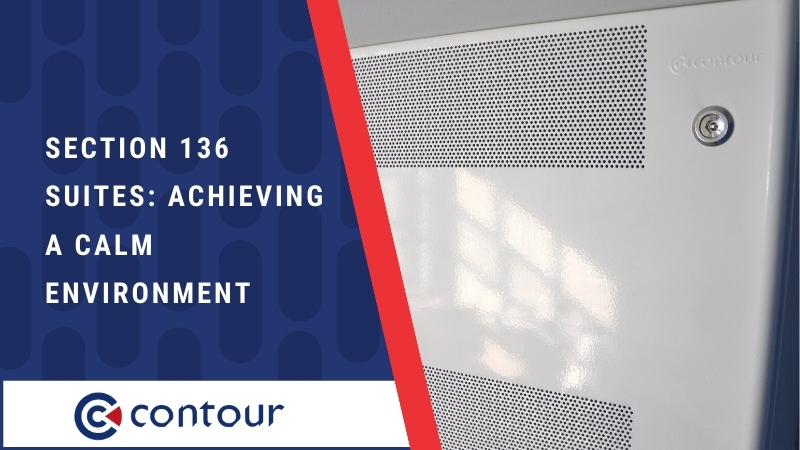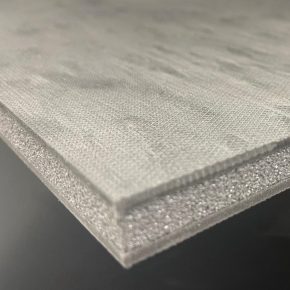
Contour: Design Considerations For Section 136 Suites – A Guide For Specifiers
A Section 136 Suite must be a safe, secure and a comfortable environment for individuals who are vulnerable and often exhibit unpredictable behaviours. For this reason, architects and specifiers must seek ways to ensure they are as secure and comfortable as possible. Contour explains more in this piece…

What Is A Section 136 Suite?
The Section 136 suite is a place of safety, security, and comfort for individuals who have been arrested by the police under the Section 136 of the Mental Health Act following concerns that they are suffering from a mental disorder.
Once these individuals are in the suite, they undergo assessment to establish whether they need treatment. This is done by qualified mental health staff, to ensure that the needs of the detained person are fully met.
Staff work to ensure the protection and dignity of the individual are preserved until a decision can be made by the assessing team as to which treatment is best for the individual.
Key Features For A Section 136 Suite
The layout of a room could enhance or restrict the feeling of serenity. Therefore, Section 136 environments have a design that encourages feelings of calmness and safety.
This is important because the environment individuals are in can increase or reduce feelings of physical security, promote/reduce mobility and impact the patients’ mental health.
Design Considerations Of Section 136 Suites
Due to the susceptibility and vulnerability of the individuals that enter Section 136 suites, furniture, fixtures, fittings and appliances must preserve safety standards and provide a comfortable environment for all service users.
For heating solutions like air conditioning guards and LST radiators, it’s important to search for a solution that:
– Is able to withstand vandalism
– Is efficient
Built To Withstand Vandalism
Vandalism is a frequent occurrence of prisoners in custodial settings and this is no different in 136 suites.
These acts of vandalism can lead to individuals creating ‘weak points’ in furniture such as doors and windows. Therefore, it’s important to search for a radiator guard or AC unit that’s strong and robust to withstand such damage.
In this case, Zintec steel material is a strong solution to protect heating from vandalism, damage, and corrosion. Zintec steel will be able to withstand acts of vandalism and provide a durable heating solution for Section 136 suites.
Heating Efficiency In Section 136 Suites
Numerous traditional radiators still work on a pipe coil system, which has several downsides from a design and efficiency perspective.
Often obtrusive and unattractive, pipe coil systems use far more water due to its wide diameter pipe. Whereas an anti-ligature radiator operates on a much smaller section of pipework, taking up less space.
Anti-ligature radiators and air conditioning guards can work to reduce the need for heating solutions to operate for lengthy periods and therefore, can heat up far quicker.
Anti-Ligature Considerations
It’s vital to understand the unpredictable state of mind of users when they’re detained and placed in a Section 136 suite.
Aggression, fear, and confusion will likely be driving the behaviours of these individuals, which is why anti-ligature products are crucial.
Radiators and air conditioning (AC) guards within 136 suites should be extremely difficult for an individual to use the appliance as a ligature risk.
Anti-Ligature Features To Minimise Harm
Keep in mind that, when individuals are looking to self-harm, they probably don’t search for obvious ligature points.
It’s commonly thought suicide risk comes from ligature points that are above head-height. However, studies have found that suicides can, unfortunately, occur where ligature points have been below the head or even at waist height.
Therefore, it’s necessary to make sure all LST radiators or air conditioning units are anti-ligature because they can be floor mounted, flat panelled, or even above head height and ceiling mounted.
To ensure the reduction of all anti-ligature risks, look at a heating solution following these certain characteristics:
– Has small grilles (IP3X rated grilles is the recommendation)
– (If wall secured) has no large gaps between the product and the wall
– Has minimal gaps or joints
– No sharp edges
– Bullnose, rounded corners
– Security locks and fixings
With these design characteristics in place, you’ll greatly lessen the possibility for service users to tie a rope or cord around any ligature points that would be easily accessed with standard grille and casing designs.
Air Conditioning Guards Offering Protection
Air conditioning guards protect AC units from damage to further improve their durability.
If vandalism occurs in a section 136 suite, air conditioning units can become weak. This leads to them losing the protection it provides for the unit underneath it.
With units being one of the costliest objects in a room, you want to be able to prevent the possibility of damages and vandalism that might occur.
To offer the necessary protection, a tip is to search for air conditioning guards that are made to be robust with strong material and opportunities to add strengthening properties if your specific needs require it.
LST Radiators Offering Protection
Low Surface Temperature Radiators (LSTs) are radiators that don’t exceed a surface temperature of 43°C.
LSTs are typically specified in environments where safety is a priority – like a Section 136 suite. To meet the needs of a Section 136 suite, an LST radiator must be anti-ligature and easy to clean.
Hygiene: Why Is It Important For Section 136 Suites?
Easy access for cleaning and maintenance is important for air conditioning (AC) units and LST radiators. This is because 136 suites experience a high turnover of individuals and fixtures can become a breeding ground for dirt and bacteria if cleaning does not routinely take place.
Another thing to consider is that AC units and LST radiators can become difficult to clean due to their positioning on walls, so specification should focus on the unique design characteristics that allow cleaning operatives to do the job thoroughly and efficiently.
Prioritising Hygiene
Vandalism in a Section 136 suite can take place in the form of a ‘dirty protest’. A dirty protest is where urine, vomit, blood, and faeces are covered over walls, ceilings, and floors, and is a common act of sabotage in many custodial settings.
When an individual urinates or defecates without the use of suitable facilities, it can pose a significant health risk to those subjected to it.
Tuberculosis, HIV, and Hepatitis C are just some of the dangers to staff and service users during a dirty protest. It’s therefore essential that appropriate cleaning practices are carried out safely and effectively.
Whilst Section 136 Suites are monitored more than prison cells, vandalism like this can still occur and therefore needs consideration.
Easy Access For Cleaning And Maintenance
Having a heating solution in place with hinges will allow them to drop down. This provides easy access for technicians to clean properly and get rid of dust and dirt that has built up.
Traditional heating solutions may require two or more people to disassemble it to thoroughly clean inside. On the other hand, heating solutions with easy access provides straightforward entry for one person to clean the guard within minutes.
This is especially important for Section 136 suites where rooms need to be available at short notice to assist users.
Introducing BioCote ®
BioCote® is an antimicrobial technology at the manufacturing stage of an LST radiator or air conditioning guard. It provides protection against several microbes, these include bacteria, mould, and some viruses.
Click here to see a list of some of the notable microbes BioCote® technology has been proven effective against. Together with cleaning regimes and hand hygiene, it provides the essential hygiene protection.
Guards are painted with a dry powder coating method, including BioCote® antimicrobial technology. In this process, the paint seals the guard, so there is protection against damage and corrosion.
The technology makes heating solutions easier to keep hygienically clean by actively working to reduce the number of microbes on the protected surface.
Colour Psychology In Section 136 Suites
Colour psychology is impactful, and it has the power to influence our feelings. In Section 136 suites, it can work to promote calmness to further the comfortability of an individual.
A plain white Section 136 suite can often feel clinical when, in fact, a suite should accommodate a calming atmosphere, as well as a practical one.
The belief is that blue and green shades provide a feeling of stability and harmony whilst red can raise blood temperature and help those experiencing weakness or fatigue. Orange can trigger mental activity, so avoid orange.
The RAL Chart
Working from a RAL chart, Contour can deliver almost any colour LST radiator, to match your colour schemes.
Conclusion
A 136 suite’s key purpose is to offer safety and security to individuals that are arrested under the Section 136 of the Mental Health Act.
Many design features need consideration to provide this level of safety and this includes the heating solutions too.
Contour can supply and manufacture anti-ligature LST radiators and air conditioning guards to meet the security levels of a 136 suite.
Contour can be contacted at;
The Mansions
43 Broadway
Shifnal
TF11 8BB
Tel: 01952 290 498
Email: [email protected]
Visit Supplier's page
Latest news

30th April 2024
Geberit exhibiting at British Pig & Poultry Fair 2024
Bathroom and piping manufacturer Geberit will be exhibiting at the British Pig & Poultry Fair at NEC Birmingham (15 – 16 May 2024).
Posted in Articles, Building Industry Events, Building Industry News, Building Products & Structures, Building Services, Exhibitions and Conferences, Facility Management & Building Services, Innovations & New Products, Pipes, Pipes & Fittings, Plumbing, Retrofit & Renovation
30th April 2024
Mitsubishi Electric and Chester Zoo partnership launch event
Chester Zoo and Mitsubishi Electric are set to announce an exciting new partnership that will see the zoo move one step closer to reach its ambitious goal of becoming net-zero by 2031.
Posted in Articles, Building Industry Events, Building Industry News, Building Products & Structures, Building Services, Case Studies, Exhibitions and Conferences, Facility Management & Building Services, Heating Systems, Controls and Management, Heating, Ventilation and Air Conditioning - HVAC, Plumbing, Retrofit & Renovation, Sustainability & Energy Efficiency
29th April 2024
Hush: New Hushlay options offer acoustic upgrade potential
Leading UK acoustic systems manufacturer Hush Acoustics has introduced two additional variants of its Hushlay Soundmatting product.
Posted in Acoustics, Noise & Vibration Control, Articles, Building Industry News, Building Products & Structures, Building Services, Facility Management & Building Services, Floors, Innovations & New Products, Insulation, Restoration & Refurbishment, Retrofit & Renovation
29th April 2024
Digital Construction Week 2024 speaker programme announced
The programme at Digital Construction Week is carefully designed to help you keep up with the fast pace of innovation in the built environment.
Posted in Articles, Building Industry Events, Building Industry News, Building Products & Structures, Building Services, Exhibitions and Conferences, Innovations & New Products, news, Posts, Restoration & Refurbishment, Retrofit & Renovation, Seminars, Sustainability & Energy Efficiency
 Sign up:
Sign up: